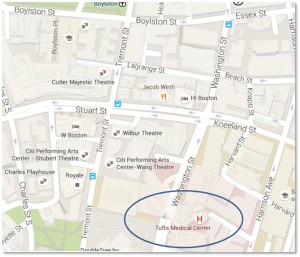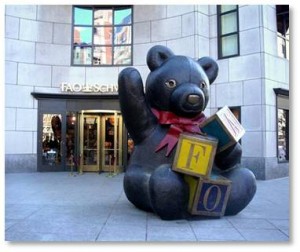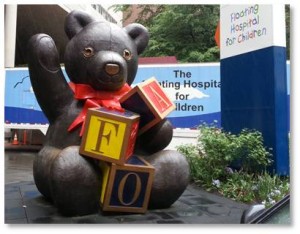Those of us who have known Boston for a few years remember the giant bronze teddy bear that used to sit on the Boylston Street sidewalk outside the FAO Schwartz toy store. Twelve feet tall, eight feet wide, and weighing in at three tons, the world’s largest teddy the bear was kind of hard to miss. He sat happily on the pavement, waving one paw and clutching at alphabet blocks spelling FAO with the other.
The Bronze Bear
Created by sculptor Robert Shure of Woburn, Boston’s bear was the first of many that the toy store placed around the country. It cost about $65,000 when it was made in the early 1990s. At least three of these store mascots—Boston, New York and Seattle—were made of bronze while the rest were fiberglass casts.
Everyone loved Boston’s bronze teddy bear. Children climbed on him. Tourists, couples, and parents in town with the family took pictures of him. Passersby touched him or said hello, even if only mentally. With his button eyes and waving paw, the bear was a big, friendly presence in the Back Bay that reminded us of happy times, childhood, and friendship.
And then, one day, the bear was gone.
Where’s the Bear?
When @FAOSchwartz declared bankruptcy in 2004 they closed all their freestanding stores except for the flagship location on Fifth Avenue in New York. The company donated Boston’s statue to the city but the bear no longer had a home. What to do with him? Three tons is a lot of bear and he needed a new place to live, one that would love and appreciate him again.
Boston’s late Mayor Thomas Menino held a contest, asking the city’s children to make suggestions. Over 7,000 entries came in from 34 states and several foreign countries, many of them written in crayon or Magic Marker on lined paper.
The kids had ideas—lots of them—and their suggestions ranged from the Franklin Park Zoo to Children’s Hospital. The winning entries came from the Tufts Medical Center/Floating Hospital for Children, thanks to an orchestrated letter-writing campaign from its young patients.
Can a Three-Ton Teddy Bear Float?
That didn’t mean the bear was going to float, however. The Floating Hospital is located on Washington Street only blocks away from his original location. The institution did gets its start in 1894 as a hospital ship sailing around Boston Harbor where the ocean air was thought to be beneficial for children. According to the hospital’s online history:
“The Reverend Rufus B. Tobey was concerned about the plight of ill, impoverished children, and proposed taking them and their mothers for a day’s outing on Boston Harbor. Not only would they get the fresh ocean air, but they would have an opportunity to be seen (at no charge) by volunteer doctors and nurses.”
That lasted through 33 years and two ships until the hospital came ashore when the second ship burned in 1927 and they decided to expand an existing facility on land rather than replace it. The land facility was affiliated with the Tufts University School of medicine and merged with it in 1965.
The bear’s new home is perfect not just for its proximity to children in need of some cheering up. Mr. Shure also created may sculptures and plaques, of both humans and animals, around New England and within Boston. Although a native of Brooklyn, N.Y., he studied at the School of the Museum of Fine Arts and Tufts University on a scholarship. Mr. Shure worked at the sculpture studio of Archangelo Cascieri and Adio deBiccari and then Lino Giust until those men retired and he founded his own studio in Woburn. He has received many awards for his work.
Directions
 The teddy bear sits outside @TuftsMedicalCtr on Washington Street and you can visit him at any time. Say hello. Wave back. Take a picture. He’s friendly.
The teddy bear sits outside @TuftsMedicalCtr on Washington Street and you can visit him at any time. Say hello. Wave back. Take a picture. He’s friendly.
Tufts Medical Center/Floating Hospital for Children
255 Washington Street
Boston, MA




“Boston, you’re my home”
Amen to that:)
I have always loved that hospital & that bear. Boston your my home.
“Boston, you’re my home.”
Amen to that:)